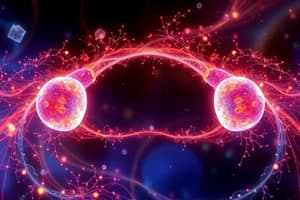Podcast
Questions and Answers
What are the three major options the liver has when experiencing elevated levels of FFAs?
What are the three major options the liver has when experiencing elevated levels of FFAs?
- Export, transform, or reduce
- Receive, produce, or excrete
- Burn, export, or metabolize
- Burn, store, or export (correct)
What is the purpose of VLDL in the liver?
What is the purpose of VLDL in the liver?
- Convert lipids into glucose for energy
- Store excess energy as fatty acids
- Export synthesized lipids to other cells (correct)
- Transport cholesterol to the kidneys
During the life cycle of lipoproteins, what transformation occurs after VLDL?
During the life cycle of lipoproteins, what transformation occurs after VLDL?
- VLDL transforms directly into HDL
- VLDL becomes triglycerides and then cholesterol
- VLDL is converted into IDL, then LDL (correct)
- VLDL is absorbed by tissues without transformation
Which apoproteins are associated with the initial formation of VLDL?
Which apoproteins are associated with the initial formation of VLDL?
What is the final clearance mechanism for LDL by the liver?
What is the final clearance mechanism for LDL by the liver?
What is the primary storage form of energy found in the liver?
What is the primary storage form of energy found in the liver?
What happens to adipose tissue during the first cycle of insulin resistance?
What happens to adipose tissue during the first cycle of insulin resistance?
Which factor contributes to the increased levels of circulating free fatty acids (FFA) during insulin resistance?
Which factor contributes to the increased levels of circulating free fatty acids (FFA) during insulin resistance?
In a state of positive energy balance, what effect does constant insulin secretion have on skeletal muscle?
In a state of positive energy balance, what effect does constant insulin secretion have on skeletal muscle?
What role do effective insulin receptors play in energy storage?
What role do effective insulin receptors play in energy storage?
What initiates the twin cycle hypothesis in T2DM?
What initiates the twin cycle hypothesis in T2DM?
Which organ is primarily involved in the first cycle of the twin cycle hypothesis?
Which organ is primarily involved in the first cycle of the twin cycle hypothesis?
What characterizes the transition from early insulin resistance to the loss of beta cell mass?
What characterizes the transition from early insulin resistance to the loss of beta cell mass?
Which of the following factors contributes to insulin resistance in the twin cycle hypothesis?
Which of the following factors contributes to insulin resistance in the twin cycle hypothesis?
What effect does leptin resistance have on caloric intake in the context of T2DM?
What effect does leptin resistance have on caloric intake in the context of T2DM?
In the context of the twin cycle hypothesis, what is a consequence of saturated energy storage options?
In the context of the twin cycle hypothesis, what is a consequence of saturated energy storage options?
Which body tissues are primarily disrupted in their metabolic processes in the twin cycle hypothesis?
Which body tissues are primarily disrupted in their metabolic processes in the twin cycle hypothesis?
What is a significant contributor to the development of T2DM as outlined in the twin cycle hypothesis?
What is a significant contributor to the development of T2DM as outlined in the twin cycle hypothesis?
How does the twin cycle hypothesis explain the role of adipose tissue in T2DM?
How does the twin cycle hypothesis explain the role of adipose tissue in T2DM?
What is the overall impact of impaired nutrient clearance in T2DM according to the twin cycle hypothesis?
What is the overall impact of impaired nutrient clearance in T2DM according to the twin cycle hypothesis?
Flashcards are hidden until you start studying
Study Notes
Energy Storage and Insulin Sensitivity
- Subcutaneous fat, glycogen, and energy storage play roles in muscle and liver, with glycogen being the primary energy source.
- Energy in the liver is also stored as glycogen, which can be converted to glucose.
- Visceral fat contains limited energy reserves, but has a role in energy homeostasis.
- Effective insulin receptors are essential for normal energy storage in healthy adipose tissue.
First Cycle of the Liver and Insulin Resistance
- Prolonged positive energy balance and insulin secretion lead to insulin resistance in skeletal muscle and subcutaneous fat.
- Elevated glucose levels remain in circulation longer, and adipose tissue becomes less effective at converting calories into triglycerides.
- Increased circulating free fatty acids (FFAs) result, necessitating liver management.
Liver's Response to Elevated Free Fatty Acids
- The liver can manage elevated FFAs through:
- Burning energy via beta-oxidation.
- Storing energy, leading to hepatic steatosis (undesirable).
- Exporting energy as very low-density lipoproteins (VLDL), increasing triglycerides (TGs) and cholesterol.
Characteristics and Lifecycle of VLDL
- VLDL synthesized in the liver contains triglycerides, phospholipids, and cholesteryl esters; important apoproteins include ApoC-II, ApoA-V, and ApoB-100.
- VLDL transforms to intermediate-density lipoprotein (IDL) which is then further converted to low-density lipoprotein (LDL) after triglyceride removal.
- LDL is cleared by liver receptors, particularly targeting ApoB-100 and ApoE.
Twin Cycle Hypothesis and T2DM
- Type 2 Diabetes Mellitus (T2DM) develops from long-lasting insulin resistance, leading to disrupted lipid and glucose metabolism across multiple organs.
- The cycle starts with insulin resistance, exacerbated by excess caloric intake and impaired nutrient clearance by muscles.
Insulin Resistance Feedback Loop
- The feedback loop involves insulin resistance escalating hepatic steatosis and VLDL output, resulting in triglyceride and FFA buildup in the pancreas, which compromises insulin secretion.
- Elevated FFAs contribute to inflammation often seen in T2DM, potentially increasing atherosclerosis risk.
Adipose Tissue Saturation
- Genetic factors determine the maximum fat storage capacity in adipose tissue, which can become saturated, leading to insulin resistance.
- Subcutaneous fat can release adiponectin, enhancing insulin sensitivity, although its secretion may lag behind leptin from visceral fat.
- T2DM alters the leptin-to-adiponectin ratio, negatively affecting food intake regulation.
Evidence and Testing of the Twin Cycle Hypothesis
- Investigations focus on confirming the hypothesis through observed changes in fatty liver, pancreatic fat, weight loss, and triglyceride levels post-T2DM treatment.
- Long-term T2DM may challenge the reversal of these cycles due to significant beta cell mass loss.
DiRECT Trial Overview
- In the UK, 306 T2DM patients underwent an intense weight-loss program, stopping all antihypertensive and antidiabetic medications while consuming 825–853 kcal/day initially.
- The purpose of the trial was to evaluate the effectiveness of dietary intervention over 12 months.
- Results indicated a significant weight loss in 24% of participants in the intervention group compared to none in the control group.
Studying That Suits You
Use AI to generate personalized quizzes and flashcards to suit your learning preferences.




